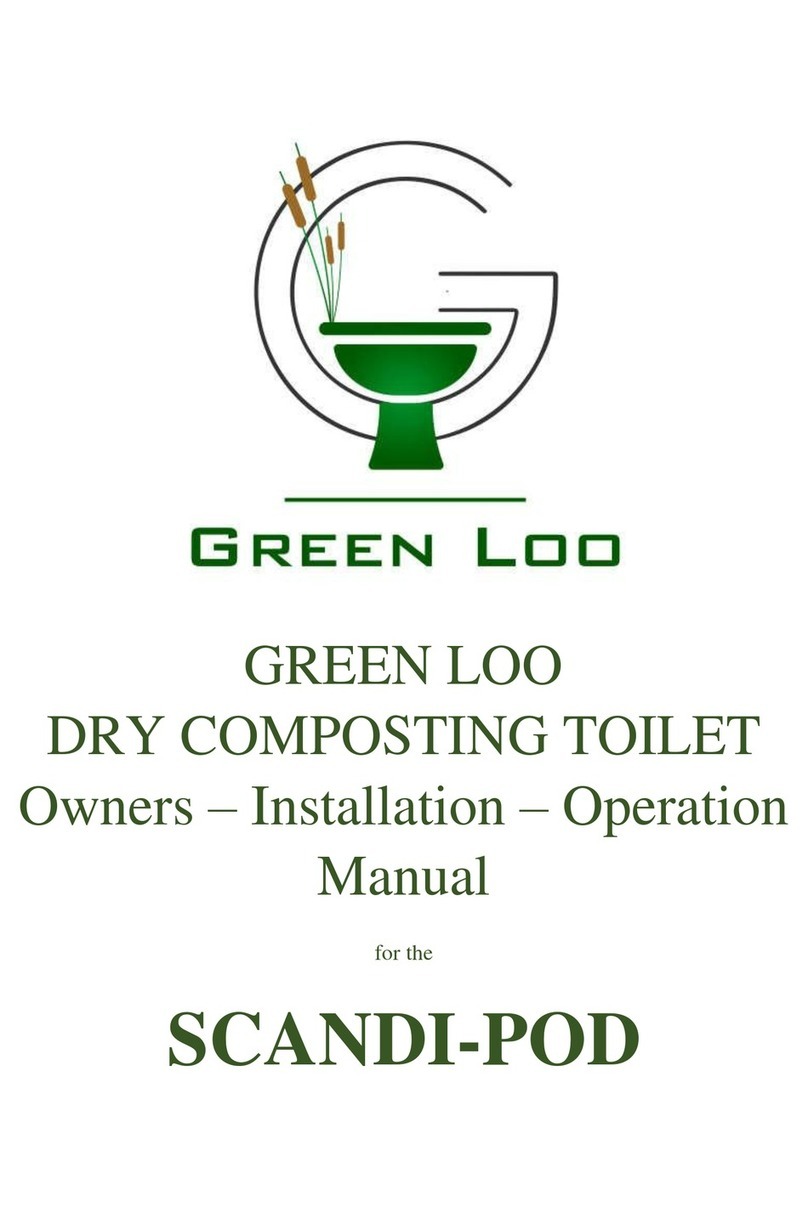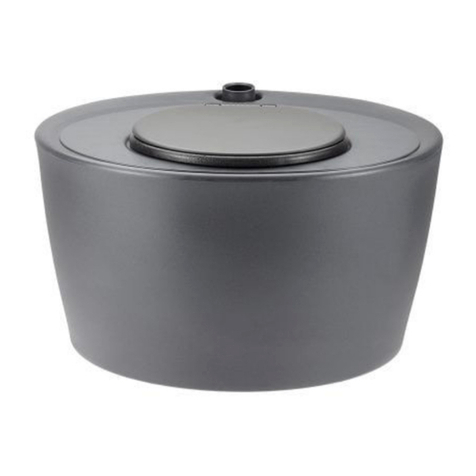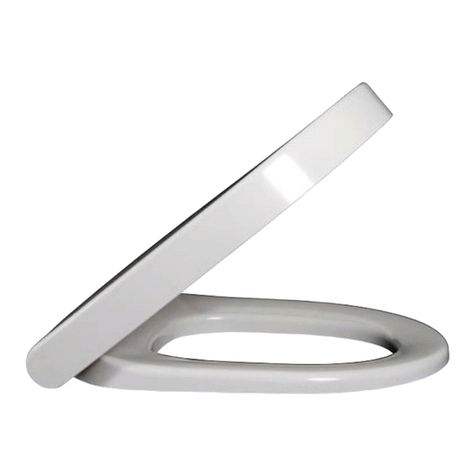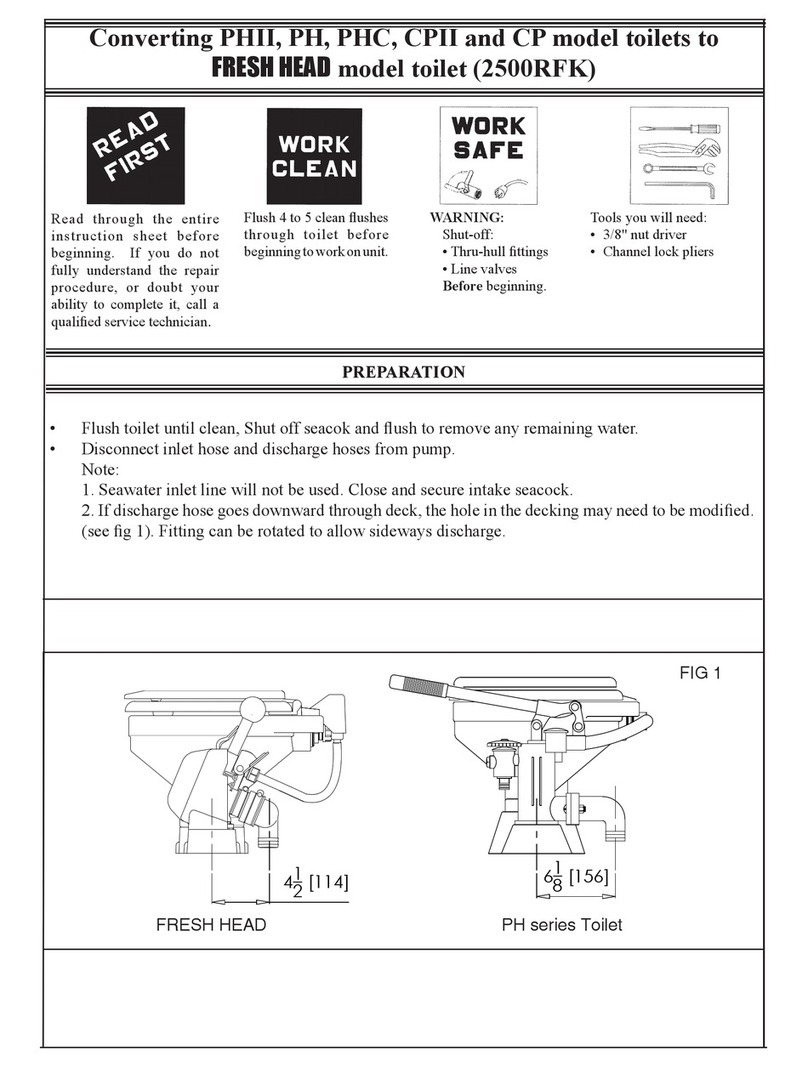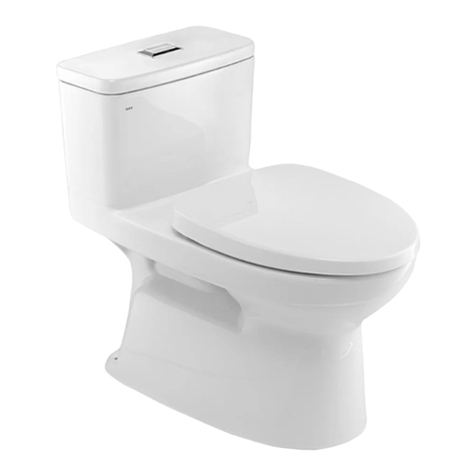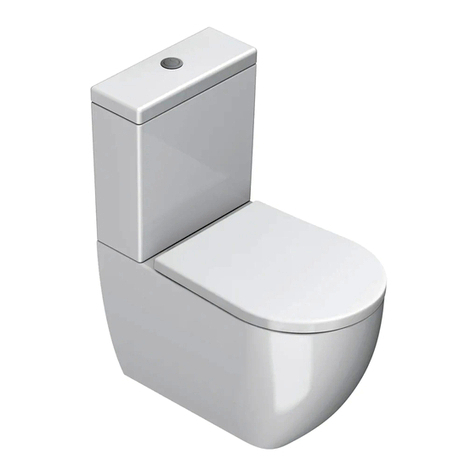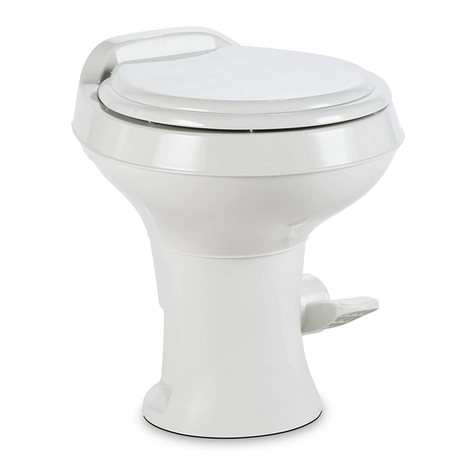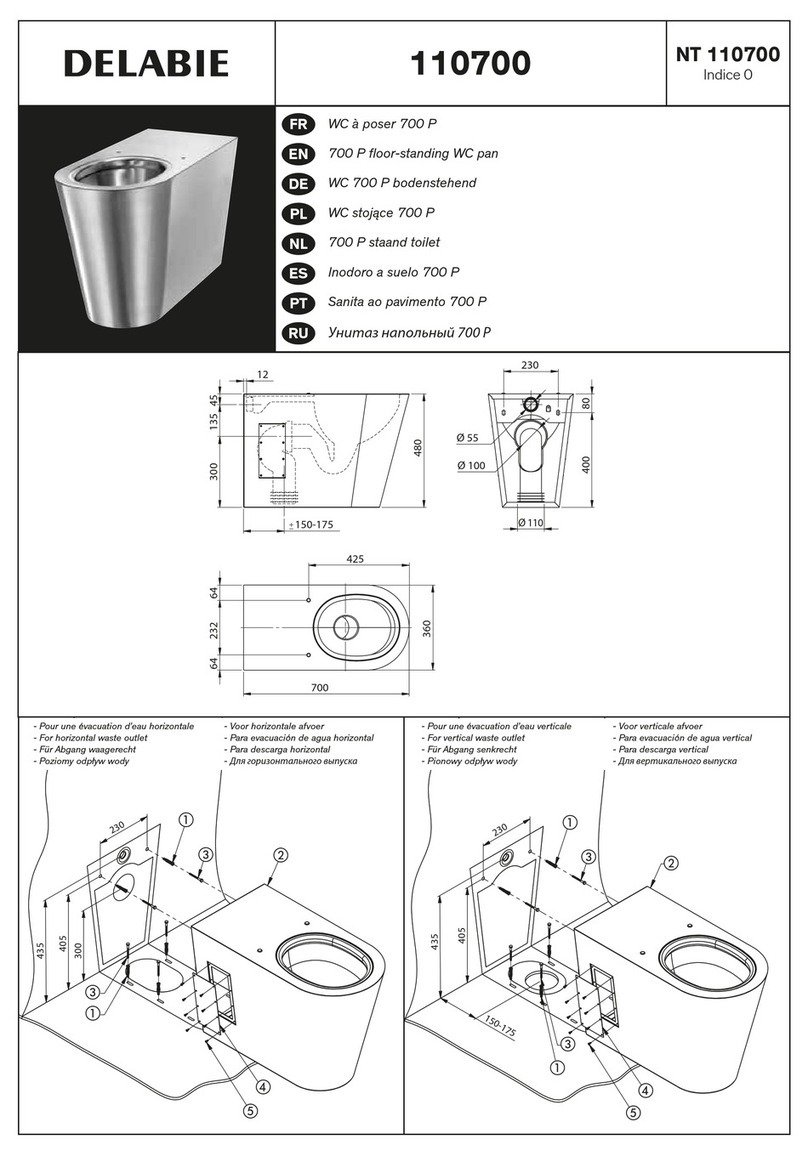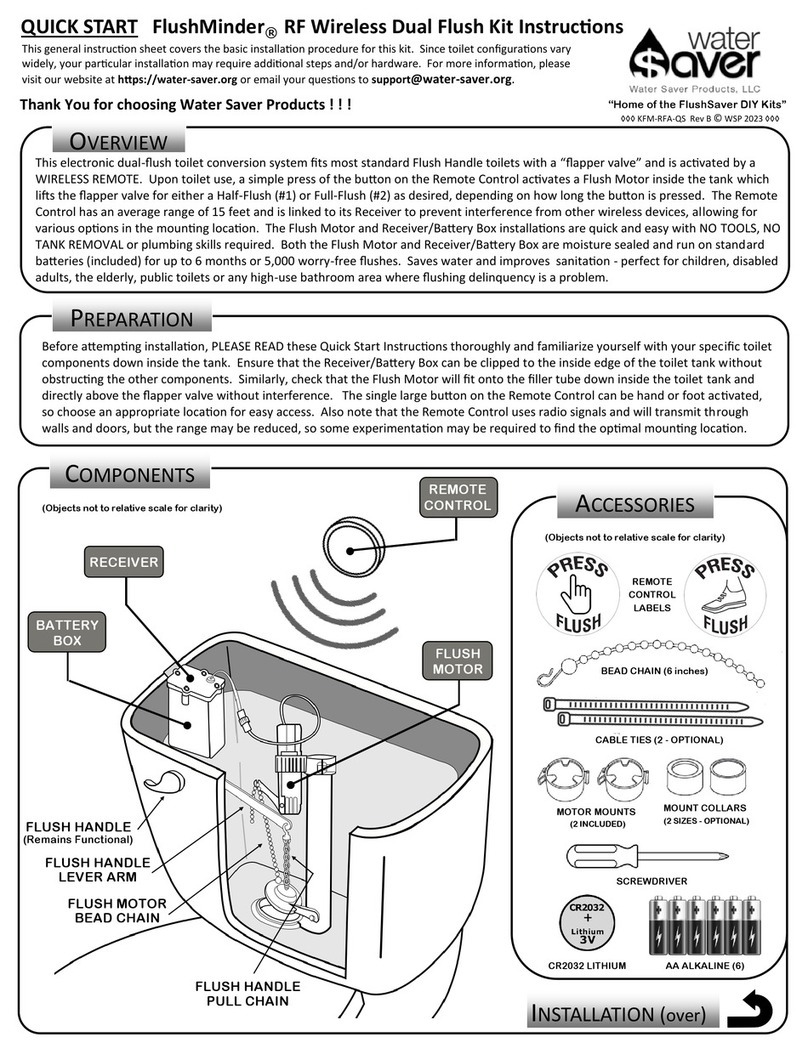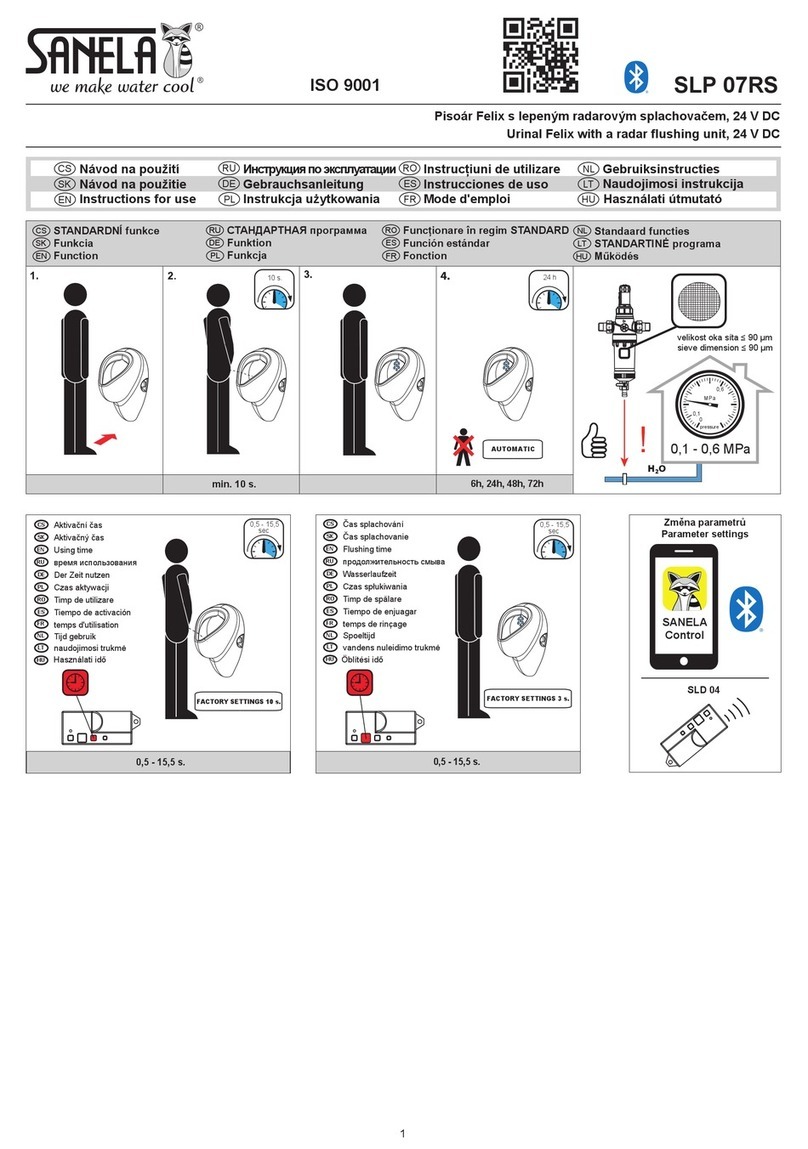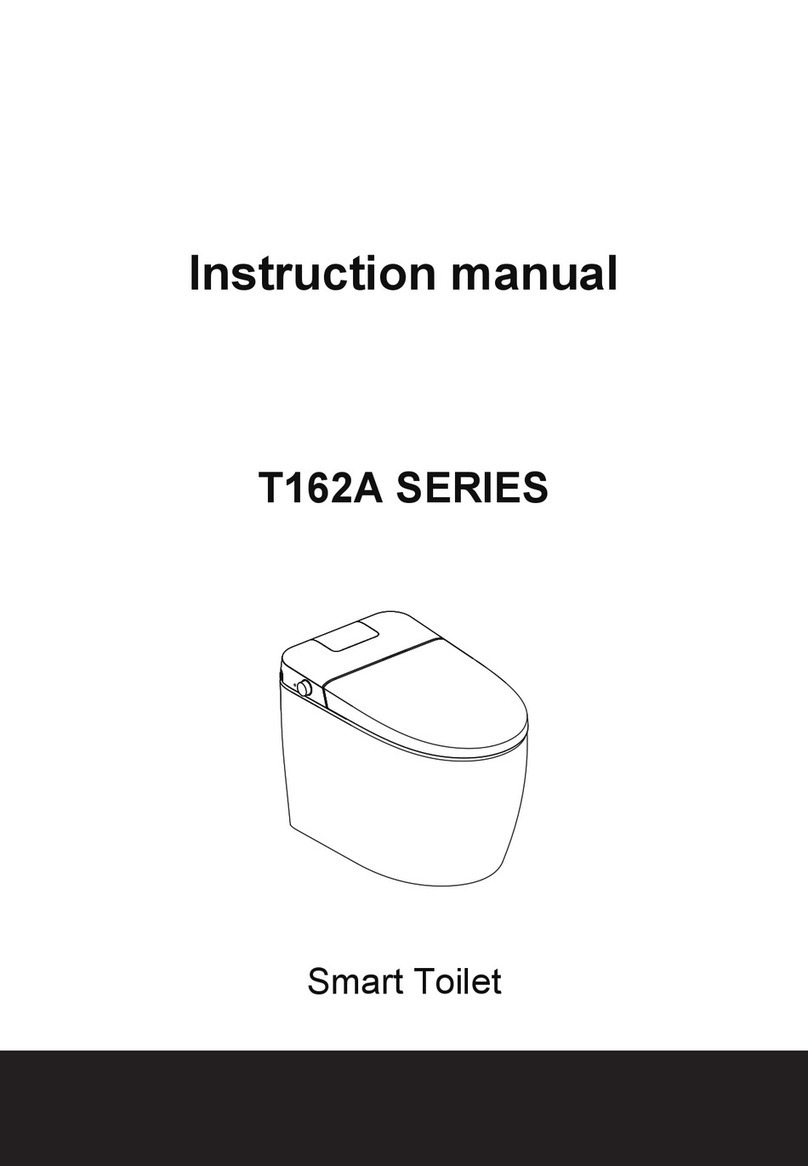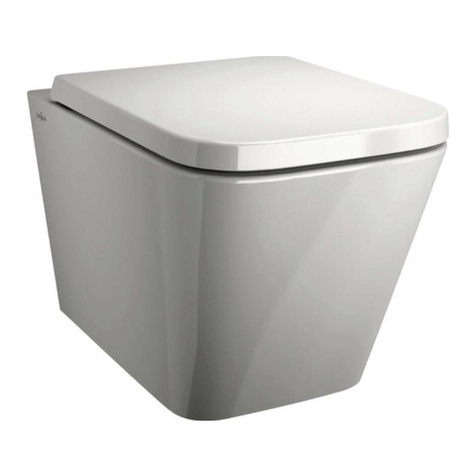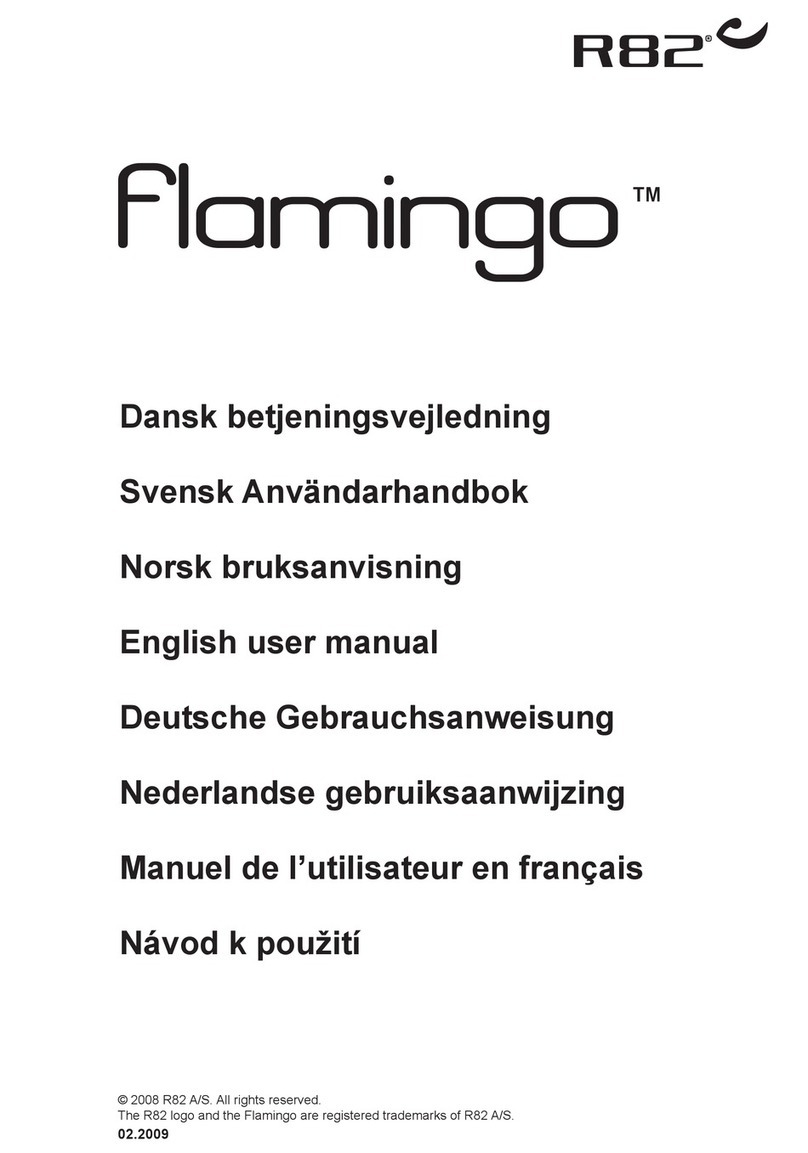GREEN LOO KIWI-POD Quick start guide

GREEN
L
OO
D R Y
COMPOST ING
TO ILET
O
w
n
e
r
s
–
I
n
s
t
a
ll
a
t
i
on
–
O
p
e
r
a
t
i
on
M
a
nu
a
l
for
t
h
e
K
I
W
I
-
P
O
D
Alsoknown as Oz-e
P
od
Ve
r
sio
n
I
V

2
INST ALL ATION
P
L
A
NN
I
N
G
I
t
'
s
all in the
p
l
a
nn
i
n
g
!
For proper
op
e
r
a
t
i
on
of the toilet you should consider a number of
i
ss
u
e
s.
T
h
e
design of the site and building needs to allow
f
or
:
•
An
elevated starting point for liquid to flow by gravity from the toilet down into a liquid
a
b
s
orp
t
i
on
trench which isto be dug outside the toilet.
T
h
e
whole toilet needs to sit on level ground,
I
F
A
N
Y
T
H
I
N
G
S
L
O
P
I
N
G
S L IG HTLY
BA C
K
W
A R
D
S
.
•
Space for the toilet and a firm, dry and
s
h
e
l
t
e
r
e
d
base for it to
s
i
t
.
•
A
d
e
qu
a
t
e
access to service and maintain the toilet, i.e. remove the fullcontainer and replace
i
t
with an empty
on
e
.
•
Good ventilation to provide oxygen and
evaporate
liquids
•
E
l
e
c
t
r
i
c
a
l
supply
(240VAC
or
12VDC)
to the fan
l
o
c
a
t
i
on
T
h
e
Oz-e-Pod is supplied as a kit containing most of the
components
required and can be
i
n
s
t
a
ll
e
d
using basic building tools and materials available at plumbing suppliers or hardware
s
hop
s
I
n
s
t
a
ll
a
t
i
on
of the
Kiwi
Pod
i
n
v
o
l
v
e
s
:
1. Preparing a flat, level and firm base for the composting container to
s
i
t
2.
I
n
s
t
a
lli
n
g
the ventilation pipe-work, including fan and vent cowl
3.
C
onn
e
c
t
i
n
g
the ventilation pipe work, electrical connection and excess liquids
p
i
p
e
4. Preparing the excess liquids dispersal
t
r
e
n
c
h
5.
Final
checks before
u
s
e
S
p
a
c
e
R
e
qu
i
r
e
d
T
h
e
r
e
is no ideal set of
measurements
which
will
suit all applications but you do need to
pro
v
i
d
e
enough space to locate and install the toilet, enough space to fit and maintain the air vent piping
and
fan and enough space to access and exchange the containers, so allow space to remove and store
t
h
e
b
i
n
s.
Don't plan to install a light directly over the
p
e
d
e
s
t
a
l
/
w
a
s
t
e
chute as this
will
attract flying
i
n
s
e
c
t
s.
D
on
’
t
use your toilet fan.
I
t
’
s
suction works against the suction of the fan of the Oz-e-Pod.
Most
Kiwi
Pods are installed indoors and are usually screwed
(drill
suitable pilot holes in base)
or
glued to the
f
l
oor
.

3
Preparing
the
Excess
L
i
qu
i
d
a
b
s
orp
t
i
on
T
r
e
n
c
h
A
lot of the liquid waste is used up in the composting process, as well as being
evaporated
t
hrou
g
h
the vent system.
An
absorption trench is required to deal with any excess liquid.
T
h
e
length of
t
h
e
trench is 1 m for the
Kiwi
Pod servicing 2 people, or 2m for the
Kiwi
Pod with 2 extra
c
h
a
m
b
e
r
s
,
servicing 4 people.
T
h
e
trench isto be 400mm wide, 400mm
d
ee
p
.
However, dimensions must not be less than required by
R
e
g
u
l
a
t
i
on
50 of the Health
(
T
r
e
a
t
m
e
n
t
of
Sewage and Disposal of
E
ff
l
u
e
n
t
and
L
i
qu
i
d
Waste)
R
e
g
u
l
a
t
i
on
s
1974 or
A
S
/
N
Z
S
1547. See
d
i
a
g
r
a
m
for an installation
b
e
l
o
w
.
1.
I
N
S
T
A
L L
A
T
I
O
N
T
h
e
first thing to do is to decide where in the toilet room you want to place the
Kiwi
Pod.
E
n
s
ur
e
y
ou
have an outside facing wall at the back of the
Kiwi
Pod for ventilation and the excess liquids
dr
a
i
n
.
Once you have found the right spot in the toilet room, either glue the
Kiwi
Pod to the floor
u
s
i
n
g
silicone or similar –or drill4 small holes through the bottom of the
Ki wi
Pod base and into the
f
l
oor
–
affix
with suitable screws or
fixings. Affix
screws at the outer edge of the base –Donot
s
c
r
e
w
through the liquids collection plate in the center! See suggestions
b
e
l
o
w
:

4
V
e
n
t
System
General
C
on
s
i
d
e
r
a
t
i
on
s
T
h
e
Kiwi
Pod airflow
r
e
qu
i
r
e
m
e
n
t
is provided by 65mm and 100mm pipe and
i
n
c
orpor
a
t
e
s
a
continuous running fan (installed with housing).
C
on
s
i
d
e
r
how the fan
will
be powered
(240VAC
or
12V DC)
and ensure the fan housing is accessible for
m
a
i
n
t
e
n
a
n
c
e
.
E
n
s
ur
e
correct airflow of the
f
a
n
away from
the
t
o
il
e
t
at
all
t
i
m
e
s
.
R
e
m
e
m
b
e
r
that warm air from the composting chamber (the composting process
generates
its
o
w
n
warmth) naturally rises, and that sharp bends restrict airflow –designing the vent piping
c
orr
e
c
t
l
y
will
improve natural
op
e
r
a
t
i
on
.
Warm air holding moisture entering a cold vent can result in
c
ond
e
n
s
a
t
i
on
.
C
on
s
i
d
e
r
insulating
t
h
e
outlet vent piping and checking your moisture
(condensate)
trap
r
e
g
u
l
a
r
l
y
.
VENT PIPE
I
N
S
T
A
LL
A
T
I
O
N
T
h
e
ventilation pipe should rise perpendicularly with as few curves and elbows as possible, the
v
e
n
t
cowl placed on top.
D
on
’
t
use pipe cement on the fan
hou
s
i
n
g
.

5
See below different vent installation options depending on roof line or needing to avoid windows
or
similar.
1. When installing the vent system, keep the 100mm vent pipe
s
li
g
h
t
l
y
away from
t
h
e
wall of the building.
This will
allow you to install the fan
hou
s
i
n
g
/
c
oup
li
n
g
a
nd
s
e
r
v
i
c
e
/
e
x
c
h
a
n
g
e
the fan in the future. We suggest using off-wallbrackets for this –
see example in the picture
‘
V
e
n
t
Pipe
I
n
s
t
a
ll
a
t
i
on
’
above -
l
e
f
t
.

6
2.
I
n
s
e
r
t
the 65mm vent pipe (supplied) onto the vent outlet of your
Kiwi
Pod.
C
u
t
a
ho
l
e
in the wall to allow the 65 mm vent pipe to traverse the wall - seal the hole w
h
e
n
f
i
n
i
s
h
e
d
:
3.
C
u
t
off the 65mm pipe on the outside of the wall far enough to allow for
t
h
e
65mm
/
100mm
T
-
J
un
c
t
i
on
to attach,
s
li
g
h
t
l
y
away from the wall.
4.
A
tt
a
c
h
your 100mm venting pipe to the wall of the building, including vent cowl.
T
h
e
vent cowl should be 600mm above where it traverses the roof
li
n
e
.
5.
A
tt
a
c
h
the
T
-
j
un
c
t
i
on
as per the picture.
Finish
with screwing on the cap.
This
is
y
our
moisture trap, which should be emptied every few weeks by undoing the cap,
l
e
tt
i
n
g
the water drain out and re-attaching the cap. (you could also drilla small hole in
t
h
e
cap to let it drain
a
u
t
o
m
a
t
i
c
a
ll
y)
6.
Allow
for a 35mm gap in the 100mm vent pipe where you
will
insert the fan &
coupling housing.
K
ee
p
the position of your power supply for this in mind as
y
ou
decide where to put the
f
a
n
:
a.
A
tt
a
c
h
the backing half of the housing at the back of this
po
s
i
t
i
on
b.
C
onn
e
c
t
the front half of the housing at the hinge
s
i
d
e
c.
Close
the
hou
s
i
n
g
d.
Slide
the trapezoid shaped fasteners over the top and bottom of the closing
mechanism. Fasten
‘
h
a
nd
t
i
g
h
t
’

7
7.
C
onn
e
c
t
your power to the jack of the vent housing, testing directional air flow
a
w
a
y
from the
t
o
il
e
t
. Apply electrical tape around the power connection to prevent any
moisture.
C
on
g
r
a
t
u
l
a
t
i
on
s
, you are
don
e
!
Excess liquids
Hose
I
n
s
t
a
ll
a
t
i
on
Due to
transport
reasons the
Kiwi
Pod is shipped with only a short length of 25mm pipe glued in
t
o
the back of the unit.
Y
ou
will
extend this with a 25mm joiner and a short length of 25mm pipe
(
bo
t
h
supplied) to traverse the wall:
Drill
the right size hole at floor level through an outside facing wall of the toilet to allow the
e
x
c
e
ss
liquids drain pipe to traverse horizontally (or
s
li
g
h
t
l
y
angled downwards).
A
tt
a
c
h
the 25mm joiner
t
o
the
Kiwi
Pod, extend with the 25mm pipe through the wall. Glue up.
C
u
t
off excess 25mm
p
i
p
e
outside the wall, allowing for the rubber joiner and hose clamp to attach. Seal hole with
s
ili
c
on
e
.

8
T
i
g
h
t
e
n
the rubber joiner with the hose clamp onto the 25mm pipe.
C
onn
e
c
t
the grey ribbed hose
t
o
the rubber joiner and connect the other end of the hose to the absorption trench.
E
n
s
ur
ethere
is
a
n
even
n
a
t
ur
a
l
fall on
the
drain hose
w
i
t
hou
t
any air
t
r
a
p
s
!
B
E
F
O
R
E
U
S
E
B
e
f
or
e
putting the system into use, line the composting chamber with our
J
u
t
e
liner and then
fill
t
h
e
composting chamber with a 2.5 - 5 cm layer of hemp.
Also,
after every emptying,
remember
to
li
n
e
with a new jute liner and add a new layer of hemp before
u
s
e
.
2.
USE OF THE KIWI
POD
T
h
e
Kiwi
Pod System can be used almost like any normal water toilet.
T
o
il
e
t
paper can be
t
hro
w
n
into the toilet, as it composts
together
with the waste. However, any items containing plastic,
e
.
g
.
sanitary towels should be placed into a
separate
bin.
A
handful of covering material (Hemp, 1
c
up
)
should be added after each bowel
movement.
Our compost starter can also be used according
t
o
instructions on the
bo
tt
l
e
.
R
e
m
e
m
b
e
r
that there isa balance
between
covering the deposit enough
visually,
and covering
i
t
excessively, resulting in the chamber
filling
up
quickly
and needing changing more
o
f
t
e
n
.
3.
S
E
R
V
IC E
a)
Check
the fan 1) monthly to ensure it is working or 2) ifyou notice unusual
odour
.
b)
T
h
e
average length of time until a container is¾ full
(recommended
exchange level) is
a
round
4–6 weeks at 2 people fulltime
u
s
e
.
c)
T
h
e
fallow containers need to be secured to prevent tampering by young children.
This
can
b
e
achieved by keeping the containers in a locked area or by securing a lockable strap
a
round
the composting container that cannot be undone by young
c
h
il
dr
e
n
.
d)
I
t
is not vital that the fallow container is kept in the sun, however composting is
a
cc
e
l
e
r
a
t
e
d
by warmth.
T
h
e
r
e
f
or
e
choosing a warm spot is helpful, as long as provision c) above is
ob
s
e
r
v
e
d
.
To
exchange or empty the
Kiwi
Pod, protective clothing, face mask, glasses and gloves must be w
orn
at all
t
i
m
e
s.
1)
T
a
k
e
the top off the
s
y
s
t
e
m.
2) Put the lid onto the container either while still inside the unit or outside.
If
whilst
i
n
s
i
d
e
,
ensure you put the lid on avoiding the carrier straps (in their holding brackets) and the
4
bungee
l
oop
s.
3)
A
tt
a
c
h
the 4 bungee loops onto the bungee
bu
tt
on
s.
4) Put the drip tray next to the
Kiwi
P
od
.
5)
L
i
f
t
the container out onto the drip
t
r
a
y
.
6)
A
tt
a
c
h
the drip tray to the composting container with the 2 bungee loops and buttons.
Y
ou
now can carry the container outside, eliminating any spillage through use of the drip
t
r
a
y
.

9
7)
R
e
m
o
v
e
to its resting spot.
T
h
e
waste
will
finish composting in this container (2 - 3 months
on
a
v
e
r
a
g
e
)
.
8)
L
i
f
t
the second container in place, securing the carrier straps into the receiving hooks
a
nd
away from any possibility of soiling.
9)
L
i
n
e
with the
J
u
t
e
liner and cover with 2.5 –5 cm of Hemp covering
m
a
t
e
r
i
a
l
.
10) When emptying a container, move to the
prepared
disposal site. Gently lay the container
on
its side and empty.
Always
observe safe work methods.
C
l
e
a
n
the container by hosing if
r
e
qu
i
r
e
d
.
4.
USE OF
C
O
M
P
O
S
T
a.
Bury
the
contents
of the container into a
prepared
area.
Burial
depth is a minimum of
300mm
in soil that is not intended for human food cultivation for
six
(6) months,
a
nd
b.
Burial
should be a minimum of 30 metres from any water source and 6 metres from any
s
ub
-
soil or open drainage system,
or
c. Disposed of as directed by the
L
o
c
a
l
G
o
v
e
rn
m
e
n
t
.
GOING
A
W
A
Y
If
you are leaving the premises for a couple of weeks or longer, it is
OK
to
h
i
b
e
rn
a
t
e
the
s
y
s
t
e
m.
Cover
the compost with a generous amount of hemp and turn the fan
o
ff
.
When re-activating the system turn the fan on and possibly add some compost
s
t
a
r
t
e
r
.
If
going away for a prolonged period of time, turn the fan off, take the active bin outside to
c
o
m
po
s
t
,
and
c
o
v
e
r
.
Start the system up as per usual on your
r
e
t
urn
.

10
10
Dear
F
r
i
e
nd
,
T
h
a
n
k
you very much for choosing our
Kiwi
Pod
Bio
S
a
n
i
t
a
t
i
o
n
S
y
s
t
e
m
.
We hope that you enjoy many years of fruitful, waterless
a
nd
t
r
o
ub
l
e
-f
r
ee
u
s
e
.
Please
d
o
n
’
t
h
e
s
i
t
a
t
e
to contact us with any questions,
s
u
gg
e
s
t
i
o
n
s
, we are here to
h
e
l
p
.
Feedback is always welcome and is an invaluable part of
pr
o
v
i
d
i
n
g
an excellent product and
s
e
r
v
i
c
e
!
Finally,
thank you for being an integral part of the
e
n
v
i
r
o
nm
e
n
t
a
l
solution.
T
h
e
E
a
r
t
h
will
thank you
t
oo
!
T
h
e
T
e
a
m
at Green
L
oo
N
Z
22 Teviotview Pl
Amberley 7410
www.greenloo.org.nz
Table of contents
Other GREEN LOO Toilet manuals
